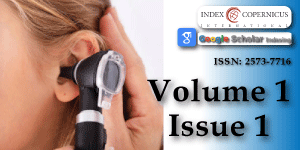Recurrent Mucoepidermoid Carcinoma of Parotid with Facial Tics - Report of an unusual case
Main Article Content
Abstract
We report an interesting case of a 21 year old male who presented with recurrent mucoepidermoid carcinoma of parotid with facial nerve involvement as facial tics. Intraoperatively, the tumour was noted to be firm, irregular and adherent to the underlying structures. The patient underwent extended total parotidectomy, division of buccal branch of facial nerve, selective neck dissection with cervical local rotational flap repair and post-operative radiotherapy. This presentation of Mucoepidermoid carcinoma with involvement of facial nerve as facial tics is one of the rare unique reported cases.
Article Details
Copyright (c) 2017 Sakthivel P, et al.

This work is licensed under a Creative Commons Attribution 4.0 International License.
Batsakis JG. Salivary gland neoplasia: an outcome of modified morphogenesis and cytodifferentiation. Oral Surg Oral Med Oral Pathol. 1980; 49: 229-232. Ref.: https://goo.gl/uEHbHO
Lewis AG, Tong T, Maghami E. Diagnosis and management of malignant salivary gland tumors of the parotid gland. Otolaryngol Clin North Am. 2016; 49: 343-380. Ref.: https://goo.gl/ErY1IS
Spiro RH, Huvos AG, Berk R, Strong EW. Mucoepidermoid carcinoma of salivary gland origin: a clinicopathologic study of 367 cases. Am J Surg. 1978; 136: 461-468. Ref.: https://goo.gl/dauIo8
Boahene DK, Olsen KD, Lewis JE, Pinheiro AD, Pankratz VS, et al. Mucoepidermoid carcinoma of the parotid gland: the Mayo clinic experience. Arch Otolaryngol Head Neck Surg. 2004; 130: 849-856. Ref.: https://goo.gl/UsSx3m
Bishop JA, Yonescu R, Batista D, Yemelyanova A, Ha PK, et al. Mucoepidermoid carcinoma does not harbor transcriptionally active high risk human papillomavirus even in the absence of the MAML2 translocation. Head Neck Pathol. 2014; 8: 298-302. Ref.: https://goo.gl/KUo7rs
Nakano T, Yamamoto H, Hashimoto K, Tamiya S, Shiratsuchi S, et al. HER2 and EGFR gene copy number alterations are predominant in high-grade salivary mucoepidermoid carcinoma irrespective of MAML2 fusion status. Histopathology. 2013; 63: 378-392. Ref.: https://goo.gl/bfjbDn
Wierzbicka M, Kopec T, Szyfter W. The presence of facial nerve weakness on diagnosis of a parotid gland malignant process. Eur Arch Otorhinolaryngol. 2012; 269: 1177-1182. Ref.: https://goo.gl/mX9VrF
Razfar A, Heron DE, Branstetter BF 4th, Seethala RR, Ferris RL. Positron emission tomography-computed tomography adds to the management of salivary gland malignancies. Laryngoscope. 2010; 120: 734-738. Ref.: https://goo.gl/2zCsfy
Vander Poorten V, Bradley PJ, Takes RP, Rinaldo A, Woolgar JA, et al. Diagnosis and management of parotid carcinoma with a special focus on recent advances in molecular biology. Head Neck. 2012; 34: 429-440. Ref.: https://goo.gl/uYMp7i
Schmidt RL, Hall BJ, Layfield LJ. A systematic review and meta-analysis of the diagnostic accuracy of ultrasound-guided core needle biopsy for salivary gland lesions. Am J Clin Pathol. 2011; 136: 516-526. Ref.: https://goo.gl/LKIuvn
Pfeiffer J, Ridder GJ. Diagnostic value of ultrasound-guided core needle biopsy in patients with salivary gland masses. Int J Oral Maxillofac Surg. 2012; 41: 437-443. Ref.: https://goo.gl/TaiJVj
Olsen KD, Moore EJ, Lewis JE. Frozen section pathology for decision making in parotid surgery. JAMA Otolaryngol Head Neck Surg. 2013; 139: 1275-1278. Ref.: https://goo.gl/q8II2U
Ettl T, Gosau M, Brockhoff G, Schwarz-Furlan S, Agaimy A, et al. Predictors of cervical lymph node metastasis in salivary gland cancer. Head Neck. 2014; 36: 517-523. Ref.: https://goo.gl/3HK2X9
Seethala RR. An update on grading of salivary gland carcinomas. Head Neck Pathol. 2009; 3: 69-77. Ref.: https://goo.gl/y6Pdb9
Chen MM, Roman SA, Sosa JA, Judson BL. Histologic grade as prognostic indicator for mucoepidermoid carcinoma: a population-level analysis of 2400 patients. Head Neck. 2014; 36: 158-163. Ref.: https://goo.gl/LaIect
Aro K, Leivo I, Makitie AA. Management and outcome of patients with mucoepidermoid carcinoma of major salivary gland origin: a single institution’s 30-year experience. Laryngoscope. 2008; 118: 258-262. Ref.: https://goo.gl/sl0RsW

